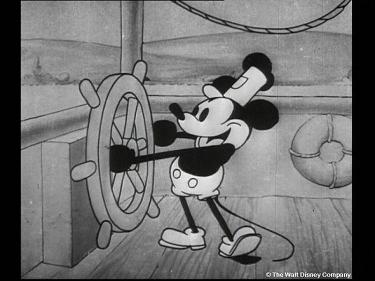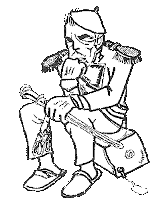The Apostle/ El Apóstol:
Release Date: November 9, 1917
Language: Silent Film/Spanish Subtitles
Running Time: 70 Minutes
Director: Quirino Cristiani
Producer: Federico Valle
Writer: Quirino Cristiani
Historical Significance:
-first feature film to use cut-out animation
-first animated feature film ever created
Background/Animation Style and Production:
Hipólito Irigoyen, the charismatic leader of the Argentinian Radical Party, won the 1916 presidential elections by a large majority, thus ending the long rule of the conservatives. The Radical Party was the party of the lower middle class and the "populist," activist segments of society. Irigoyen was an honest man, but somewhat absentminded; the victim, some said, of unscrupulous associates. Moreover, he and his fellow Radicals lacked the polished style of the conservatives: they tended to be long-winded, with a certain tendency toward demagoguery. All these factors made Irigoyen an ideal target for the young cartoonist, who was eager to make fun of everyone and everything.
The film, El Apóstol (The Apostle), showed Irigoyen wanting to bring morality to public life and eliminate corruption in Buenos Aires. To accomplish his lofty aims, he ascends to heaven where Jupiter lends the new president his thunderbolts. Irigoyen then hurled the redemptive fire at the city, which made for a most impressive blaze. The audience particularly enjoyed the final sequence, which combined models built by the French architect Andrés Ducaud and special effects.
El Apóstol had its premiere on November 9, 1917 at the Select Theater (which co-producer Franchini owned). "The film is magnificent," said the review in the newspaper Critica, "and demonstrates the wonderful progress our national cinema has made."La Razon agreed, saying it was, "A graphic work that reveals enormous labor, patience and even genius." A good many other papers praised Valle, the film, and the country. But hardly anyone noticed that Cristiani had the one true claim to authorship: He had conceived the film, made the drawings, and animated the characters. In those days, no one thought of filmmakers--films were spoken of something "produced" by someone.
Cristiani's life was complicated by the fact that Valle had hired Diógenes Taborda, known as "El Mono" ("The Monkey," as was apparently very ugly), to design characters for the film. El Mono was the most famous humorous cartoonist of the time; a veritable star, his vaguely art nouveau cartoons would sell any journal in which they appeared. But Taborda had no desire to devote his life to something he knew nothing about, and cared to know nothing about. He would make two or three drawings and then turn the rest over to Cristiani, who could do whatever he wanted ... as long as Taborda's name got the largest billing in the credits. Everyone was happy with this arrangement (especially Valle, who was only interested in buying El Mono's popularity), and so the deal had been struck. The friendship between the two artists was sealed when Taborda served as best man at Cristiani's wedding. (The press, who had not heard otherwise, printed the name of Taborda as the artist who made El Apóstol, forgetting the film's humble "animator.")
El Apóstol was an hour and ten minutes long and was said to be composed of 58,000 drawings, which means 58,000 frames, as the film was made utilizing cutouts. All known copies of the film were lost in a fire in Federico Valle's vaults in 1926.
Monday, June 13, 2011
Wednesday, June 1, 2011
The Tale of the Fox
The Tale of the Fox/Le Roman de Renard:
Release Date: Germany: April 10, 1937/France: April 10, 1941
Running Time: 65 minutes
Director: Irene Starevich/ Ladislas Starevich
Producer: Louis Nalpas (1929-31)/Roger Richebé (1939-41)
Historical Significance:
- the third animated feature film to have sound
- stop-motion animation pioneer Ladislas Starevich's first fully animated feature film
- one of the world's first-ever animated feature films and one of the first to use puppet animation
- stop-motion animation pioneer Ladislas Starevich's first fully animated feature film
- one of the world's first-ever animated feature films and one of the first to use puppet animation
Background:
The question of animation in the Nazi era has been largely ignored or even falsified. Starewich's Le Roman de Renard, although it was largely shot in Paris around 1930, has been completely ignored in discussions of "the first feature-length animation film" because it finally received its finishing funds from German sources (since Goethe had written a classic version of the Reynard legend) and had its world premiere in Berlin in April 1937--still eight months before Disney's Snow White (December 1937).
In fact, dozens of animators worked in Germany before and during the Nazi era, including such relatively forgotten names as Kurt Wiese, Otto Hermann, Hans Zoozmann, Lore Bierling, Toni Rabolt, Harry Jaeger, Kurt Wolfe, Kurt Kiesslich, Curt Schumann, Kurt Stordel, Richard Felgenauer, Bernhard Klein, Paul Peroff, the team of Hedwig and Gerda Otto, the team of Schwab and Gerhardt--as well as such slightly better-known figures as Louis Seel, the Diehl brothers (who made more than fifty puppet films), Rudolf Pfenninger, Wolfgang Kaskeline, Lotte Reiniger, and the Fischinger brothers--Hans and Oskar.
Plot Summary:
In the kingdom of animals, the fox Renard is used to tricking and fooling everyone. Consequently, the King (a lion), receives more and more complaints. Finally, he orders Renard to be arrested and brought before the throne.
Animation Style and Production:
The Tale of the Fox, called Le Roman de Renard in France, and Reinecke Fuchs in Germany, was stop-motion animation pioneer Ladislas Starevich's first fully animated feature film. It is based on the tales of Renard the Fox. Although the animation was finished in Paris after an 18-month period (1929-1930), there were major problems with adding a soundtrack to the film. Finally, funding was given for a German soundtrack by the Nazi regime (Goethe had written a classic version of the Renard legend) and this version had its premiere in Berlin in April 1937. Released eight months before Disney's Snow White, it is the world's sixth-ever animated feature film. The film was released in France with a French language soundtrack in 1941.
Funny Tidbits You Didn't Know:
- As you are aware by reading this post, the German version of this film was funded by the Nazi regime. While I cannot condone the director's need to let them pollute this film, artistically and story-wise, this is film will be featured and discussed on the original French version, as it was meant to be. As the German version has cease to exist, and for personal reasons, I will only focus on this version. Hate the directors, not the movie.
Subscribe to:
Posts (Atom)





